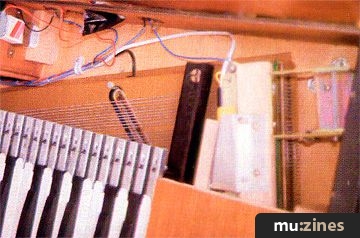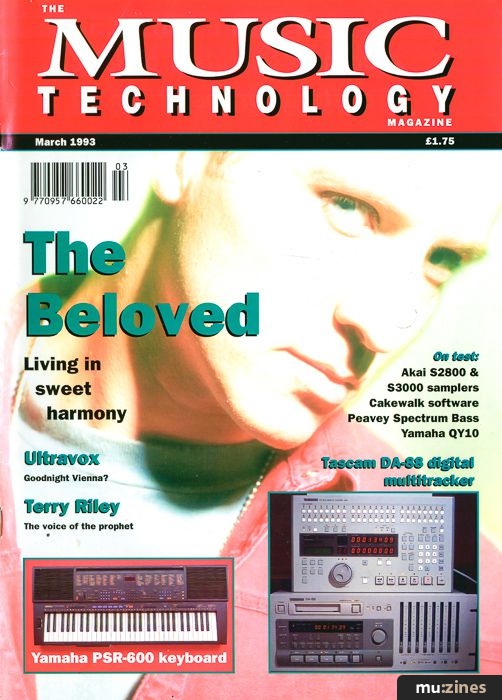Magazine Archive
Home -> Magazines -> Issues -> Articles in this issue -> View
Wonderstuff | |
Article from Music Technology, March 1993 | |
The Clavinet revisited
It's stayed on the scene and for many it's the ultimate funk machine - but will the Clavinet take its place alongside the Hammond and the classic analogue synths as a keyboard to be seen with in the nineties..?

One of these days, someone with a spare year or two will take it upon themselves to begin a comprehensive survey of synthesiser 'factory' sounds and find out which ones manufacturers have considered essential enough to use in their machines. Right up there near the top of the list would be the Clavinet. There are two reasons for this: first, the classic Clavinet sound is, admittedly, quite easy to imitate (passably, anyway). Second, it's extremely useful, not just for funk workouts, but any time you want a clean, rhythmical sound that can inject a bit of pace and choppy counterpoint into a track.
Of course, the nearest most synth imitations get to the Clavinet is the sharp 'plunk' (for want of a better expression) of its most commonly used sound. The quintessential example of this is probably Stevie Wonder's excellent 'Superstition', a single which also appeared on the 1973 Talking Book album, and more recently as the opening track on the CD compilation Original Musiquarium I - Volume I. Interestingly, Volume II of this compilation kicks off with the other classic Stevie Wonder Clavinet track, 'Higher Ground' ("People... keep on learning..."). Together, these two songs have done more for the Clavinet's reputation than any amount of advertising and have made it an essential instrument for any keyboard player in funk or soul bands.
If the Clavinet is not an instrument you're familiar with, let me fill you in. It's basically an electrically amplified version of a clavichord. Clavichords were very popular as home instruments in the Baroque period (they were too quiet to be used in performance) until they were eventually replaced by the piano as the essential home keyboard. Their action is very simple and consists of a metal blade - a 'tangent' - attached to each key which strikes a pair of strings and makes them vibrate.
One section of the strings is damped to stop it vibrating while the other vibrates freely and produces the note. Unlike most instruments of this kind, the tangent stays in contact with the strings and makes it possible to produce vibrato by applying a bit of finger-wobble to the key. In contrast to the harpsichord it's also touch-sensitive and a fiercely-struck note will tend to sound slightly sharp as well as being louder and brighter.
The Clavinet shares most of these attributes. It is simply a set of single strings, mounted transversely, which are damped at one end (by strands of ordinary wool, would you believe?) and set in motion by little beaters attached to the keys. The makers referred to it as a hammer and anvil arrangement, because there's another surface for the string to be pressed against. The gauge of the strings, incidentally, is roughly equivalent to the guitar. Like its ancestor, the Clavinet is also free of any tendency on the mains supply: though a 9V adaptor is available, the machine can just as easily, be run from a PP3 battery - the only thing that draws current is the small preamp used to amplify signals from the strings.

After its invention by Ernst Zacharias of German manufacturers Hohner (some time around 1960), the Clavinet went through various design changes, but the best known model is almost certainly the D6. (The later E7 was almost identical except for case construction and finish.) The classic D6 was quite a handsome instrument with a top made of good quality veneered blockboard and sides of ply covered in black vinyl. There was also a tough vinyl-covered ply cover which acted as a flightcase and could be taken off its hinges and stashed away when the keyboard was in use.
Inside this cover was storage space for the transparent music holder, and the lid of the instrument was hinged so that you had access to a storage compartment for the legs and to the battery, when necessary. Imagine, if you would, a modern keyboard that runs off a PP3 and has space in the cabinet to stow the detachable legs!
The controls were pretty straightforward: on the left of the keyboard was the volume knob which also doubled as an on/off switch, and there were six rocker switches to control tone. Four of these (brilliant, treble, medium and soft) are self-explanatory, and, I would guess, switched in or out some pretty basic tonal circuitry - either individually or in combination. The other two switches are a little less straightforward. Labelled A/B and C/D, they control the two pickups in the Clavinet and can be set in any one of four combinations.
Both pickups are actually mounted at the right-hand end of the strings, but one is angled across some distance along, while the other is positioned at a right angle close to where they are secured to the frame. The different tonal effects achieved through the use of two pickups are obviously similar to those produced on a guitar or bass. At its simplest, the pick-up closer to the bridge produces the harder, drier, less bassy sound.
The pick-ups are both split half-way across the strings - that's how the four pick-up selections are possible - and you can have combinations of, say, the bass middle pick-up with the treble end pick-up, or the two bass pick-ups together - and so on. As so often happens, it is probably the technical imperfections of this design which are responsible for the Clavinet's highly distinctive sound. You often seem to get phase cancellations between the two pick-ups, which would be disastrous in a straight clavichord impersonation, but sound great in an electric instrument with a character of its own.

The only other control is a slider on the right of the keyboard which is used as a variable damper. The more you move it away from you, the more the strings are damped. More instant character. Pizzicato is a doddle; you can alter the damping in real time, and as the effect is, not surprisingly, much more far-reaching on the treble than the bass strings, you can have the two ends of the keyboard functioning with very different decay times. Admittedly, it would be nice if it could work the other way round, with a staccato bass and sustained treble, but the technology just won't allow it.
While we're on the subject of what would make the Clavinet an even better instrument, it would have been great to have had a device to lift the strings off the dampers altogether, so that you could have the natural sustain and decay of the strings if you want - as on a zither or even a piano - but as far as I know, Hohner never put this into practice (possibly because it wouldn't have done any good for the instrument's pitch stability).
Which reminds me: it comes as a shock to many Clavinet owners to discover their instrument occasionally needs tuning. In fact, this is probably one of the few times you might decide that a synth with a decent Clavinet voice is preferable to the real thing - particularly if you need to record or play live. In theory it should be fairly simple to tune. All you have to do is undo two thumb-screws on the front, lift off the long metal cover and take a screwdriver to the tuning screws.
"Imagine, if you would, a modern keyboard that runs off a PP3 and has space in the cabinet to stow the detachable legs!"
The trouble is, not all keyboard players are that adept at tuning a guitar, let alone an instrument with ten times as many strings. Okay, you can start with A=440, and work around it in octaves and fifths and so on. But I've tried it and it isn't easy - particularly if people are starting to look at their watches and you've got to play in several keys. A chromatic tuner (and a good deal of time) helps of course, but a friendly piano technician might be a better bet. This, unfortunately, is the price you have to pay for using a real instrument.
Also to be considered is the weight of the Clavinet and the fact that it takes up a significant amount of room. It's not surprising that you don't see them in use much nowadays; who's going to bother carrying round a heavy, comparatively unreliable instrument when its best-known sound can be imitated by any of a number of cheap synthesisers or modules? Even in the studio, it's hard to justify the space taken up by a Clavinet when set alongside (say) a 1U multitimbral rackmount.

But then, people used to say that about the Hammond and look how many bands go to the trouble of using the real thing these days - or at the very least using a dedicated module to re-create its sounds. I wouldn't be at all surprised if the same happens with the Clavinet. For one thing, the feel of the keyboard is subtly different from any MIDI controller; for another (and this is perhaps more important), the actual instrument produces a variety of tones which I've never heard any synthesiser imitation come near.
It's not just the raunchy two-handed funk riffs that seem to flow effortlessly from its strings - nor the left-hand riffs that double so brilliantly with electric bass. There are other much more subtle sounds which you can coax out of it. As an example: if I wanted to play Irish folk music, I could think of no better keyboard instrument to use than a Clavinet. Played lightly, it has a sound somewhere between an acoustic guitar and a zither, but it's far easier to play fast, cleanly-articulated lines on than on either of those two instruments.
Since getting my Clavinet six months ago (I had a feeling you were more than an impartial onlooker, Peter - Ed), I've been listening out for examples of its use on recordings. Some of them are what I expected - funk/dance tracks like Sylvester's 'You Make Me Feel', and 'Dance (Disco Heat)'; Tim Buckley's 'Freeway Blues', and Funkadelic's 'Loose Booty' - not to mention a load of Mass Production material, more Stevie Wonder 'I Wish', and Billy Preston on the Stones' Goat's Head Soup album.
One surprise I did get, however, was when it suddenly clicked that a lot of Bob Marley material features a Clavinet amid the masses of other early keyboard instruments the Wailers used. Tracks like 'No Woman No Cry', 'I Shot The Sheriff, 'Get Up, Stand Up' and 'Concrete Jungle' all use it, though perhaps the clearest example is 'Burnin' and 'Lootin', where the Clavinet plays that distinctive descending riff, doubling the bass, and mixes it with backbeat syncopations throughout the song.
On a lot of Marley songs, the Clavinet is heavily wah-wahed - the wah-wah seems to have suited it as well as it did electric guitar. Other frequently-used effects were chorus and phase, and these still sound good if you use them today. Of course, the real advantage of using a Clavinet at the present time is opportunity to use it with modern, digital effects. The results can be very impressive: a long reverb does wonders for the Clavinet's more gentle and reflective sounds, while a harsh, early-reflections program makes the funkier voices sound really wicked.
As for recording the Clavinet, the ideal situation is probably to mike it up to a good old valve amp like a Fender Twin Reverb or even an AC30; but failing that, the Clavinet can make any amp sound pretty good. And if you want to avoid having to use headphones (it's a semi-acoustic instrument, remember), you can DI it. The output is surprisingly clean, and of course you're not going to have any problems with earth loops without a mains cable. There doesn't even seem to be a great difference between using a DI box and going straight into the desk, which makes life even easier.
If you're looking for a particularly meaty sound, you can either double it with a bass guitar or synth, or boost the low mid on the mixer input channel. Despite having strings no thicker than a guitar's low E, this is usually all that's required to make the Clavinet sound pretty solid at the low end.
Using a Clavinet live should certainly make a change from the ubiquitous Korgs, Yamahas and Rolands. You'd need to be slightly crazy, of course, and it would only be worth it if you made full use of the Clavinet's innate versatility - or if the instrument was such a centre-piece of your sound that you could justify it. Better, perhaps, simply to make sure your rack has something in it that can produce a half-decent imitation of the basic funk sound. There's no way that anyone would want to return to the massed banks of keyboards that hemmed in the pomp merchants of the late seventies. Is there?
Buying a Clavinet
Expect to pay around £150 for a decent specimen - and you could well be lucky and find one for even less - but it may not be too long before hire companies and collectors start taking an interest and pushing the price up.
More with this topic
Inside The Synclavier (Part 1) |
A Gallery of Misfits (Part 1) |
Total recall - Doctor Beat - Vintage technology strikes back |
The Famous Five: Synths |
Taurus Taurus Taurus - Bass Pedals |
Analogue Synths - In The Digital Age |
Return Of The Prophet |
Interfacing The Past (Part 1) |
Sampling A Vintage |
The A-Z of Analogue (Part 1) |
Total Recall - Coachbuilt classic |
Uncle Bob's Baby - The Minimoog in 1985 |
Browse by Topic:
Vintage Instruments
Publisher: Music Technology - Music Maker Publications (UK), Future Publishing.
The current copyright owner/s of this content may differ from the originally published copyright notice.
More details on copyright ownership...
Feature by Peter Forrest
Help Support The Things You Love
mu:zines is the result of thousands of hours of effort, and will require many thousands more going forward to reach our goals of getting all this content online.
If you value this resource, you can support this project - it really helps!
Donations for April 2024
Issues donated this month: 0
New issues that have been donated or scanned for us this month.
Funds donated this month: £7.00
All donations and support are gratefully appreciated - thank you.
Magazines Needed - Can You Help?
Do you have any of these magazine issues?
If so, and you can donate, lend or scan them to help complete our archive, please get in touch via the Contribute page - thanks!



















